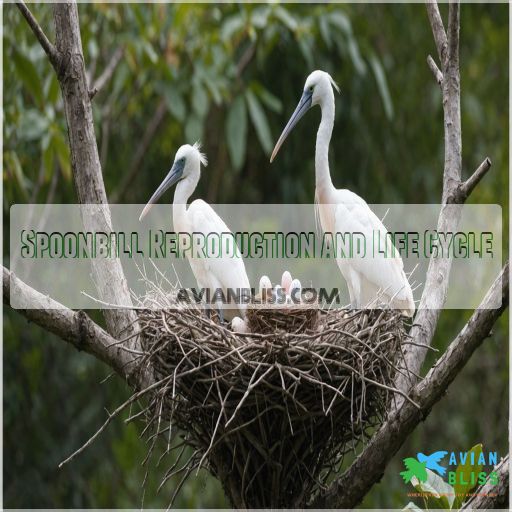This site is supported by our readers. We may earn a commission, at no cost to you, if you purchase through links.

You’ll find them sifting through shallow waters, using their sensitive bills to catch small fish and crustaceans. Spoonbills are social butterflies, often seen in flocks, engaging in elaborate courtship dances during breeding season.
They’re not just pretty faces though – these birds play a key role in their ecosystems. These birds are vital to the balance of their environments.
While some species face threats from habitat loss, conservation efforts are helping them bounce back. There’s more to these pink-feathered friends than meets the eye – stick around to uncover their secrets!
Table Of Contents
- Key Takeaways
- Spoonbill Habitat and Distribution
- Spoonbill Diet and Feeding Ecology
- Spoonbill Reproduction and Life Cycle
- Spoonbill Conservation and Human Interaction
- Spoonbill Behavior and Social Structure
- Spoonbill Origins and Taxonomy
- How to Identify Spoonbills
- Spoonbill Health and Disease
- Spoonbill Care and Management
- Interesting Facts About Spoonbills
- Frequently Asked Questions (FAQs)
- Are spoonbills flamingos?
- Why do spoonbills turn pink?
- Are spoonbills native to Florida?
- What states have spoonbills?
- How long do spoonbills typically live?
- Can spoonbills fly long distances?
- Do spoonbills have any natural predators?
- How do spoonbills communicate with each other?
- Are there any cultural significance to spoonbills?
- Conclusion
Key Takeaways
- You’ll be amazed by spoonbills’ unique, ladle-like bills, which they use to sift through shallow waters for food. It’s like they’re nature’s own living soup spoons!
- These social birds love to flock together, showcasing complex behaviors that’ll make you wonder if they’re running their own avian social club in the wetlands.
- Don’t be fooled by their rosy hue – spoonbills aren’t flamingos in disguise. They’re related to ibises and get their pink color from a diet rich in crustaceans. Talk about "you are what you eat"!
- You can help protect these fascinating birds by supporting Florida wetland conservation efforts wetland conservation efforts
. Remember, a healthy habitat means happy spoonbills, and who doesn’t want to see more of these pink-feathered wonders wading around?
Spoonbill Habitat and Distribution
You’ll find spoonbills wading through shallow wetlands, marshes, and mangroves across the globe.
While their distribution varies by species, these unique birds can be spotted in freshwater, saltwater, and brackish habitats that provide ample food and protection.
Types of Habitats
You’ll find spoonbills loving diverse habitats, from wetlands and mangroves to mud flats. They’ve got some neat tricks up their sleeves for survival.
Consider their habitat preferences:
- Wetland adaptations: Essential for these clever wading birds.
- Mangrove dependence: Offers breeding sanctuary and protection.
- Saltwater tolerance: Key for thriving through seasonal shifts.
Geographic Distribution
Spoonbills grace wetlands across continents, each with its unique range and variation.
From the roseate spoonbill in the Americas’ warm waters to the black-faced spoonbill in Asia, they share habitats with other waders despite conservation concerns.
Distribution maps reveal habitat overlap, emphasizing the need to protect diverse ecosystems for these majestic birds, including the African, royal, and Eurasian varieties.
Migration Patterns
A spoonbill’s migration patterns are a fascinating journey. Picture them following vast migration routes from breeding sites in North America to winter havens. Timing is key, often peaking in mid-October. Factors like weather influence their paths, posing challenges.
Similar to wood storks’ adaptability in Wood Stork Range Migration, spoonbills also adjust their routes based on environmental conditions. However, their specific migration patterns differ greatly from those of wood storks.
Groups like Partners in Flight monitor these patterns, ensuring conservation strategies are effective and spoonbills thrive throughout their breeding season.
Habitat Loss and Conservation
Facing habitat loss, the roseate spoonbill, or platalea ajaja, depends on wetland restoration and community action for conservation.
Everglades National Park is a key habitat under threat. Protecting these wading birds challenges us to tackle future threats, like habitat degradation.
By understanding and acting, you can help keep their unique habitats safe and thriving for generations to come (Source).
Spoonbill Diet and Feeding Ecology
You’ll be amazed at how spoonbills use their unique bills to catch a variety of small aquatic creatures, including fish and insects, by expertly swaying them through water.
These fascinating birds adapt their diet based on seasonal availability, showcasing their impressive feeding ecology in maintaining ecosystem balance.
Diet Composition
In understanding spoonbills’ diet composition, consider these four aspects:
- Prey Types: Ranging from fish and crustaceans to insects.
- Seasonal Variations: Chicks might rely more on freshwater prey initially due to limited salt tolerance.
- Geographic Differences: Diet shifts based on habitat availability.
- Food Availability: Influenced by environmental changes, affecting prey abundance and competition.
By grasping these, you’ll better understand their feeding ecology.
Feeding Behavior
You may have noticed spoonbills’ unique feeding behavior – they sweep their partially open bills from side to side as they wade, capturing small crustaceans and fish.
This specialized technique, driven by the bill’s hydrofoil shape, creates vortices that lift prey off the bottom and into the bird’s mouth.
Quite an ingenious adaptation!
Tactile Feeding Technique
Equipped with unique bill adaptations, spoonbills excel at tactile feeding. As you observe, they gracefully swing their heads side to side in shallow waters, using sensory organs to detect prey. Their technique enhances feeding efficiency through evolution.
Remember these keys:
- Spoonbill bill adaptations assist in prey detection.
- Tactile feeding evolution refines their method.
- Sensory organs boost success.
Prey Preferences
Spoonbills don’t just wave their beaks around for fun; they’re fans of small fish over shrimp. They often feast on juvenile flatfish and gobies, favoring areas with ample prey availability.
Observing them, you’d see their unique feeding techniques shine, avoiding competition with other birds.
Spoonbills forage in shallow aquatic environments, such as mangrove ecosystems, where they use their specialized beaks to filter-feed on small aquatic creatures, including insects, crustaceans, and amphibians.
These habitats allow them to thrive in a variety of environments, from marshes to swamps. It’s all about finding that perfect snack swimming by.
| Prey Type | Preference Level |
|---|---|
| Small Fish | High |
| Shrimp | Low |
| Gobies | Medium |
Seasonal Diet Shifts
Exploring seasonal diet shifts in spoonbills offers a fascinating glimpse into their adaptive strategies.
These shifts reflect:
- Seasonal Prey Availability: They rely on abundant freshwater and marine prey, adapting as the seasons change.
- Breeding Season Diet: Feeding strategies shift to support chick rearing.
- Migration Impact: Spoonbills face food competition, influences diet adjustments essential for winter survival strategies.
Spoonbill Reproduction and Life Cycle
You might think spoonbills have a straightforward life, but their reproduction and life cycle are full of fascinating intricacies.
From elaborate courtship displays to cooperative chick rearing, each stage is key to ensuring the survival of the next generation.
Breeding Season
During breeding season, spoonbills craft nests in colonies, often in mangroves or shrubs.
Both sexes participate in egg incubation, which lasts about 22 to 24 days, ensuring the eggs are well-tended.
Once hatched, chick rearing involves both parents, who feed and protect the young until they’re ready to venture out on their own.
Courtship Displays
Imagine roseate spoonbills beginning their courtship displays, capturing attention with visual cues and vocalizations.
These birds engage in dance routines to win a mate’s affection, clattering bills and performing ritual exchanges of nest materials.
It’s a delicate ballet of balance and commitment, as the male selects twigs and leaves, while the female builds the nest, ensuring future harmony .
Nesting and Egg-laying
Once the courtship rituals are complete, spoonbills get down to the serious business of nesting.
They’ll select a spot, often in a tree or shrub near the water’s edge.
The female builds a bulky platform nest using sticks, moss, and bark.
She’ll lay 2-5 white or pale blue eggs, which both parents will take turns incubating for around 3-4 weeks, during this period of incubating.
Incubation and Chick Rearing
Eggs safely nestled in their chosen site, you now watch spoonbills embrace their parental roles. Both parents share incubation duties, ensuring warmth and protection.
As chicks hatch, they rely on careful feeding techniques. Adults bring low-salt prey, essential for chick development.
The incubation period of spoonbill eggs can last around 20-30 days, depending on factors such as egg size and weight. Threats include predators and environmental changes, requiring constant vigilance.
| Aspect | Detail |
|---|---|
| Parental Roles | Shared incubation |
| Nest Site | Safe, protected areas |
| Chick Development | Low-salt diet needed |
| Feeding Techniques | Regurgitated food |
| Threats to Chicks | Predators, environment |
Fledging and Independence
Spoonbills face a critical stage when fledging arrives.
Parental care remains essential as young spoonbills refine their foraging skills and navigate social interactions to boost fledgling survival.
Migration timing becomes key, helping them join flocks ready to explore new habitats.
With newfound freedom, they leave their nests, excited to embrace independence and venture into their wide, watery world.
Spoonbill Conservation and Human Interaction
When you think about spoonbills’ survival, you’ll quickly see that habitat loss, pollution, and disease pose significant threats to their populations.
Conservation efforts, along with community involvement and education, play critical roles in protecting these unique birds and their fragile ecosystems.
Threats to Spoonbill Populations
You know, spoonbill chicks rely on stable environments.
However, climate change throws a wrench in their foraging plans.
Rising sea levels and pollution impact their delicate habitats, while invasive species compete for limited resources.
Throw in overfishing effects and disease outbreaks, and it’s a tough gig ensuring survival.
Being proactive in addressing these threats is key .
Habitat Loss and Degradation
Picture a bustling wetland, vital for spoonbills, now fragmented by urban sprawl and climate change impacts.
You can champion wetland restoration, helping these birds reclaim their lost homes. With habitat fragmentation, prey dwindles, pushing spoonbills to new areas.
By understanding and addressing invasive species, together we can lessen pollution effects and guarantee these habitats endure, supporting the birds’ survival through climate change impacts.
Pollution and Disease
Understanding pollution impacts on spoonbills reveals a complex web of challenges.
Here’s how it plays out: Industrial pollution and sewage threaten habitats, causing disease outbreaks like avian botulism. Excessive fertilizers pollute waters, affecting food sources .
Conservation strategies demand research needs and community involvement for effective solutions. Every effort counts to help their survival.
Conservation Efforts and Organizations
Dedicated conservation groups like the Taiwan Black-faced Spoonbill Conservation Association work tirelessly to protect these iconic birds.
They monitor populations, restore wetlands, and educate locals – all essential efforts to safeguard the spoonbill’s future.
Meanwhile, the IUCN lists the species as Endangered, highlighting the need for continued funding and action.
Community Involvement and Education
Conservation organizations can’t do it alone—your involvement through community outreach and education programs makes a big splash.
Citizen science projects invite you to monitor spoonbill populations, aiding local conservation efforts.
Engaging students in habitat restoration connects them to nature while fostering awareness.
Together, we keep these pink-feathered wonders a key part of our ecosystems, ensuring they remain a vital part of our environment and that we can continue to appreciate these pink-feathered wonders.
Spoonbill Behavior and Social Structure
When examining spoonbill behavior and social structure, you’ll notice their preference for living in large flocks.
This preference aids in foraging efficiency and protection against predators.
These birds engage in elaborate mating rituals, maintain territories, and communicate through a series of vocalizations and physical gestures, which showcase their complex social structure.
Flocking Behavior
Spoonbills often gather in flocks, using their group size for predator defense and enhancing communication during their migration journeys.
You’ll find them roosting together, sharing spaces with herons and ibises, which strengthens these social bonds.
Observing their flocking patterns offers insight into their communal behavior and the ways they maintain harmony within a complex ecosystem.
Mating and Pair Bonding
Imagine the gentle dance of courtship rituals. Spoonbills engage in these displays, exchanging sticks and selecting nest sites with care.
Mating pairs often showcase mate fidelity, strengthening bonds through shared chores like brood care.
They also exhibit a unique form of mating known as a "cloacal kiss," where male and female birds align their cloacas for a brief touch cloacal kiss for fertilization. This pair bonding can last through the breeding season, offering a fascinating glimpse into their cooperative behavior and the dedication to their offspring.
Territoriality and Aggression
When understanding spoonbills, you’ll see that territoriality and aggression are key.
They engage in:
- Breeding disputes, often leading to dramatic nesting conflicts.
- Food competition, where dominance hierarchy dictates who gets the best catch.
- Inter-species aggression flares as they defend territory.
- Persistently protecting nesting sites, ensuring their young thrive in peace.
These behaviors highlight their complex social structure.
Communication and Vocalizations
For spoonbills, sounds play a huge role. As you wander through their habitat, you might hear their vocalizations—courtship calls buzzing in love-struck air, or loud alarm signals warning of danger. Curious chick begging calls echo melodically.
Here’s a quick look:
| Vocalization Type | Purpose | Example Context |
|---|---|---|
| Courtship Calls | Attracting mates | During mating season |
| Alarm Signals | Warning of threats | Predator sighting |
| Chick Begging | Parental feeding | Nest interactions |
Understanding these calls can deepen your appreciation for these fascinating birds.
Foraging and Roosting Behavior
As a spoonbill, you’ll often forage in small to large flocks, sweeping your bill through shallow waters to catch crustaceans and small fish.
You may even "sky gaze" – raising your neck and bill when you spot other spoonbills flying overhead.
When it’s time to rest, you’ll gather with your flock in trees or shrubs near the water’s edge, engaging in social behavior as part of a flock.
Spoonbill Origins and Taxonomy
When you’re studying spoonbills, understanding their origins and taxonomy is like piecing together a fascinating puzzle, revealing their evolutionary history and classification.
Spoonbills fit into the broader picture of bird species, highlighting their unique characteristics and the diversity found within their family tree.
Evolutionary History
Understanding spoonbill behavior, you might ponder their evolutionary history.
Their fossil record reveals ancient ancestors with early forms of beak evolution, adapting over time.
These graceful birds share traits with related species, hinting at shared roots. They have developed evolutionary adaptations that have fine-tuned their beaks, making them adept foragers, showcasing nature’s balance of form and function, with a focus on ancient ancestors .
Classification and Phylogeny
Spoonbills belong to the Threskiornithidae family, sharing evolutionary relationships with ibises.
Their taxonomic history reveals a fascinating journey through molecular phylogeny, highlighting genetic diversity and species divergence.
Researchers use DNA sequences to explore these birds’ origins, tracing back their lineage. This helps you appreciate how genetic diversity shapes their taxonomy and deepens our understanding of spoonbill classification .
Species Diversity and Characteristics
Wonder about spoonbill diversity? These fascinating birds feature distinctive bill shapes that help them feed in unique ways, such as the roseate spoonbill’s spoon-shaped bill that sweeps side-to-side to filter small creatures wood stork vs roseate spoonbill.
Their feeding behaviors, like cooperative feeding and sharing resources, also play a key role in their adaptability.
Their plumage variations, from roseate to white, adapt to geographic ranges stretching from Asia to the Americas.
Understand their evolutionary history and conservation status to appreciate this remarkable group, whose survival depends on protecting important habitats.
Subspecies and Variation
With six distinct species, you’ll appreciate how spoonbills boast plumage differences and bill variations that suit their geographic ranges.
Each subspecies has unique behavioral adaptations and faces different conservation challenges:
- Exotic bill shapes are perfect for fishing.
- Vibrant plumage attracts mates hilariously well.
- Shallow waters become their dance floors.
- Wide geographic homes offer boundless freedom.
- Habitat changes test their survival instincts.
Fossil Record and Ancient Spoonbills
Recognizing the intriguing variations among spoonbill subspecies invites curiosity about their ancient origins.
Fossil evidence highlights these fascinating dinosaurs of the bird world, revealing extinct species and evolutionary adaptations.
Historically, ancient distribution patterns indicate their widespread presence.
Paleontological research uncovers secrets of these long-gone creatures, offering a window into the past and the forces that shaped today’s spoonbills (Source), and revealing their ancient origins.
How to Identify Spoonbills
You can easily identify spoon-shaped bills by their distinctive appearance.
You can look for their white or pink plumage, depending on the species.
Their unique feeding behavior involves sweeping their bills through the water to catch small prey.
Visual Identification
Spotting a spoonbill in the wild is easy if you know what to look for.
Their spoon-shaped bill, long legs, and striking plumage color are key identifiers.
You’ll often find them in their preferred habitat, foraging in shallow waters, using unique feeding behavior.
They fly with necks and legs extended, a distinctive silhouette (Source).
Bill Shape and Size
The spoonbill’s bill is its most distinctive feature. You’ll notice its long, flattened shape with a spoon-like tip . This unique bill morphology is a product of evolution, perfectly adapted for efficient feeding in shallow waters.
Here are four key aspects of the spoonbill’s bill:
- Shape: Elongated and flattened, with a broad, rounded tip
- Size: 27.9-33.9 inches in length
- Function: Sweeps through water to scoop up prey
- Adaptation: Enhances feeding efficiency in various aquatic environments
Plumage and Coloration
Spoonbills’ plumage is a sight to behold, with their iconic pink feathers stealing the show.
You’ll notice their coloration intensifies with age and diet, thanks to carotenoids from shrimp-rich meals .
Molting patterns reveal seasonal changes, while plumage variations help you distinguish between species.
Keep an eye out for their distinctive silhouette in flight, with outstretched necks painting the sky in rosy hues.
Leg and Foot Characteristics
While you’re admiring a spoonbill’s vibrant plumage, don’t forget to look down! Their legs and feet are just as fascinating. These wading birds have adapted perfectly for life in shallow waters.
Here’s what to look for:
- Long, bright red legs for effortless wading
- Three forward-facing toes and one backward-facing toe
- Feet designed like snowshoes to prevent sinking in mud
- Large foot size relative to body for stability in water
These adaptations make spoonbills expert waders and swimmers.
Behavioral Identification
Spotting spoonbills isn’t just about looks; it’s their behavior that’ll catch your eye.
You’ll see them sweeping their distinctive bills through shallow waters, foraging with a side-to-side motion. Unlike herons, they hold their bodies horizontally when feeding.
In flight, they’re unmistakable with outstretched necks and legs.
During courtship, watch for their noisy flocking in trees, where they roost and nest with other wading birds.
Spoonbill Health and Disease
You’ll find that spoonbills face several health challenges, including avian botulism, influenza, parasitic infections, lead poisoning, and injuries.
Understanding these threats is essential for conservation efforts and helps protect these unique wading birds in their wetland habitats.
Avian Botulism
Now that you can spot a spoonbill, let’s talk about a serious health threat they face: avian botulism. This deadly disease is caused by a toxin produced by the bacterium Clostridium botulinum.
You’ll notice affected birds struggling to fly or hold up their heads. It’s like they’ve had one too many at the bird bar! But it’s no laughing matter – botulism can lead to paralysis and drowning .
Early detection is key to managing outbreaks and saving these beautiful birds, and it is crucial for managing outbreaks.
Avian Influenza
Avian influenza, the silent threat, can strike spoonbills like lightning.
You’ll want to keep an eye out for this highly contagious virus that spreads through infected birds’ secretions. It’s not just a bird problem; mammals, including us humans, can catch it too.
The impact on spoonbills can be devastating, from mild symptoms to severe illness and death.
Prevention is key, so stay informed about outbreaks and follow guidelines to protect these unique birds.
Parasitic Infections
Numerous parasites can affect spoonbills, impacting their health and well-being.
You’ll find that helminth infections are particularly common, with studies showing up to 89% of roseate spoonbills carrying these parasites. They may lead to eggshell thinning and developmental issues.
While treatment options are limited in wild populations, prevention strategies focus on habitat management.
Research areas include understanding parasite life cycles and their effects on spoonbill populations, helping us protect these unique birds through prevention strategies.
Lead Poisoning
While parasites can be troublesome, lead poisoning poses a grave threat to spoonbills. You’ll find these birds ingesting lead from various sources, often mistaking pellets for food or grit.
Lead poisoning‘s impact on spoonbills is severe:
- Inability to fly or move
- Tremors and ragged breathing
- Decreased immune function
- Long-term behavioral changes
Even a tiny amount, "as small as a grain of rice," can be deadly. Prevention strategies include using non-toxic alternatives and proper disposal of lead-containing items.
Trauma and Injuries
Spoonbills face various physical threats in their environment.
You might spot them with fractured wings, bill injuries, or wounds from wildlife collisions and predator attacks. Human interaction poses risks too – discarded fishing tackle often ensnares these birds, causing severe injuries.
Habitat degradation and environmental toxins further complicate their survival.
If you encounter an injured spoonbill, it’s essential to act fast. Quick intervention can mean the difference between life and death for these unique creatures, highlighting the importance of human interaction.
Spoonbill Care and Management
You’ll find managing spoonbills requires specialized knowledge and facilities. Their care involves captive breeding programs, rehabilitation efforts, proper nutrition, enriched enclosures, and regular health monitoring.
Captive Breeding Programs
Captive breeding programs play a key role in spoonbill conservation.
These initiatives tackle challenges head-on, from genetic diversity to ethical considerations.
For instance, the Fort Worth Zoo has been successfully breeding roseate spoonbills since 1967.
These programs have seen remarkable successes, like the hand-rearing of chicks using specially customized formulas.
They’re not just about numbers; they’re about understanding these fascinating birds and ensuring their future in the wild.
Rehabilitation and Rescue
A soaring challenge awaits in spoonbill rehabilitation. You’ll face intricate rescue missions and careful release protocols. Rehabilitation centers become sanctuaries of hope, where these unique birds find healing and strength. Public involvement is key, from reporting injured birds to supporting rescue efforts. Post-release monitoring makes sure their successful return to the wild.
Here’s how you can make a difference:
- Report distressed spoonbills promptly
- Support local wildlife rescue centers
- Participate in beach cleanups to prevent entanglements
- Educate others about spoonbill conservation
Dietary Requirements
Throughout the seasons, you’ll notice that spoonbills’ dietary needs vary.
In captivity, you’re tasked with mimicking their natural diet of small fish, crustaceans, and aquatic insects.
It’s a balancing act, ensuring they get the right mix of nutrients while considering prey availability and potential food competition.
Remember, these pink beauties owe their rosy hue to carotenoid-rich foods like shrimp.
Tailor their diet to match seasonal changes and nutritional requirements for the best possible health.
Enclosure Design and Enrichment
You’ll want to create a slice of spoonbill paradise in your enclosure.
Maintain pristine water quality for their sensitive bills. Offer varied foraging opportunities like shallow pools with live fish.
Encourage social interaction by providing ample space for flocking. Don’t forget nesting areas – these birds love to build homes.
Stimulate their senses with different textures and natural elements. Remember, a happy spoonbill is an active, engaged spoonbill!
Health Monitoring and Veterinary Care
Stethoscopes and feathers intertwine in spoonbill care. Regular health checks are essential for disease prevention.
You’ll need to monitor for common issues like avian botulism and influenza. Implement strict biosecurity measures to protect your flock.
When illness strikes, consult an avian medicine specialist for specific treatment protocols.
Remember, ethical considerations should guide all veterinary interventions. By staying vigilant, you’re not just a caretaker – you’re a guardian of these magnificent birds’ well-being.
Interesting Facts About Spoonbills
You’ll discover fascinating aspects of spoonbills, from their unique bill shape to their complex social structure.
These remarkable birds possess iridescent plumage, form monogamous pairs, and have adapted to thrive in diverse wetland habitats.
Unique Bill Shape and Function
Every spoonbill sports a remarkable bill, shaped like a flattened spoon.
This unique adaptation isn’t just for show – it’s a highly efficient feeding tool. As you watch a spoonbill sweep its bill through shallow waters, you’re witnessing a marvel of bill evolution.
The hydrofoil shape generates swirling flows, drawing prey closer. This feeding efficiency allows spoonbills to capture fish, crustaceans, and insects with ease.
Iridescent Plumage
Dazzling in the sunlight, spoonbills’ iridescent plumage catches your eye.
These feathers aren’t just for show; they serve important functions.
Iridescent feather variations play a role in breeding displays, with males using their vibrant colors to attract mates.
The plumage’s evolution has refined its ability to reflect sunlight, potentially aiding in temperature regulation.
This coloration also helps spoonbills blend into their wetland habitats, a clear example of nature’s clever designs. Spoonbills’ iridescent plumage proves to be multifunctional and beneficial for their survival.
Monogamous Mating
While spoonbills don’t sport iridescent plumage, they’ve got something equally fascinating: monogamous mating. You’ll find these birds pairing up for the breeding season, forming strong bonds. It’s like they’re writing their own love story each year!
Here’s what you need to know about spoonbill romance:
- Males woo females with gifts of nesting material
- Pairs take turns incubating eggs and feeding chicks
- Courtship can start aggressively before turning tender
- Both parents care for their young for weeks after fledging
Complex Social Structure
Among spoonbills, you’ll find a complex social tapestry.
These birds aren’t loners; they’re social butterflies, often seen in the company of their own kind and other wading birds. You’ll spot them foraging, roosting, and flying in formation together.
Their flocking dynamics showcase a tight-knit community, with intricate communication methods and a social hierarchy that governs their interactions. It’s like they’ve got their own avian social club!
Adaptations For
Spoonbills have evolved some remarkable adaptations for survival in their watery habitats.
You’ll be amazed by these unique features:
- Spoon-shaped bills for efficient feeding
- Pink plumage from their crustacean-rich diet
- Ability to sleep standing on one leg
- Tactile feeding technique to catch prey
These adaptations help spoonbills thrive in various climates, from nesting in trees to scooping up food in shallow waters. Their specialized bills and feeding habits make them well-suited for life in wetland ecosystems.
Frequently Asked Questions (FAQs)
Are spoonbills flamingos?
Despite their rosy hue, these birds aren’t your granddaddy’s flamingos.
You’re looking at roseate spoonbills, distinctive waders with spoon-shaped bills.
They’re related to ibises, not flamingos, and get their pink color from crustaceans in their diet.
Why do spoonbills turn pink?
You’ll find the secret to their rosy hue in their diet.
These birds feast on carotenoid-rich shrimp and algae, which deposit pigments in their feathers.
The more they eat, the pinker they become.
Are spoonbills native to Florida?
Home is where the heart is.
And for roseate spoonbills, that home includes Florida.
These vibrant birds are native to the Sunshine State, gracing coastal areas like Florida Bay and Tampa Bay with their distinctive presence.
What states have spoonbills?
Roseate Spoonbills primarily breed in Florida, Texas, and Louisiana.
They’ve been spotted in coastal states from Connecticut southward, with recent sightings as far north as New Hampshire, Massachusetts, and Michigan .
You’ll find these pink-feathered waders exploring both salt and freshwater habitats.
How long do spoonbills typically live?
Like vibrant flowers in nature’s garden, these birds bloom for a decade in the wild.
You’ll find they typically live 10-15 years, flourishing in their coastal habitats.
In captivity, they’ve been known to thrive for over 30 years.
Can spoonbills fly long distances?
You’d be amazed at their aerial prowess.
These birds can cover vast distances, from Florida to Maine – a journey of 1,500 miles.
They’re built for long-haul flights, with wingspans reaching 4 feet.
Do spoonbills have any natural predators?
Natural predators lurk in their habitats. You’ll find birds of prey swooping down, raccoons raiding nests, and even fire ants causing trouble.
In coastal areas, alligators pose a threat, though they also deter other predators from approaching nesting sites.
How do spoonbills communicate with each other?
Birds of a feather flock together, and spoonbills are no exception.
You’ll hear them utter low, guttural sounds while feeding.
They also communicate through calls during breeding displays and flight, fostering social bonds within their colonies.
Are there any cultural significance to spoonbills?
Cultural significance can be fleeting,
but these unique birds have left their mark.
Once prized for feathers, they’re now symbols of conservation success.
You’ll find them in art, folklore, and as ambassadors for wetland preservation.
Conclusion
By a stroke of serendipity, spoonbills have captured our attention and imagination. These unique waders, with their distinctive bills and social nature, play a vital role in wetland ecosystems worldwide.
As you’ve discovered, spoonbills face challenges from habitat and pollution, but conservation efforts are making a difference.
Your newfound knowledge about their behavior, diet, and life cycle equips you to appreciate and protect these fascinating birds. Remember, every action counts in preserving spoonbills and their habitats for future generations to marvel at and enjoy.













